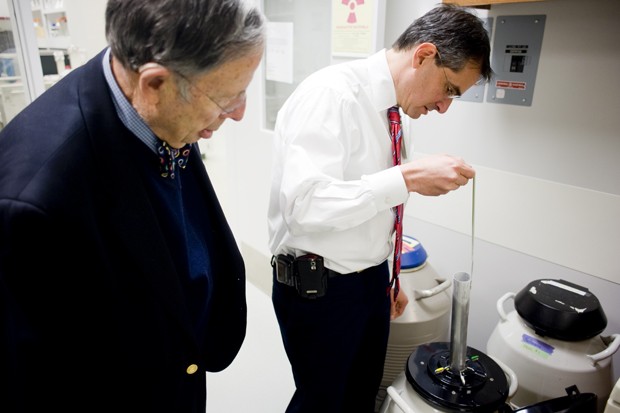A nationwide salmonella outbreak has killed at least six people and hospitalized more than 100. But University of Minnesota researchers arenâÄôt afraid. TheyâÄôre going to be giving it to cancer patients. The salmonella outbreak, traced back to a Georgia peanut butter plant, has spread the bacteria, and the lurking fear of infection, across the United States. But University researchers plan to treat gastrointestinal cancer by infecting people with a genetically altered strand in clinical trials, set to begin in late spring. The nature of salmonella, which thrives in low oxygen environments, made peanut butter an ideal hiding place, Craig Hedberg , professor of environmental health sciences at the University, said. The salmonella could be used to treat cancer in a place where the bacteria can thrive, like the colon and intestines. The genetically engineered salmonella treats cancer in two ways: the human immune system naturally grows stronger while fighting bacteria, and the genetically altered salmonella holds Interleukin-2 , a naturally occurring cancer fighter in the body, Dr. Daniel Saltzman , part of the research team and head of pediatric surgery at University ChildrenâÄôs Hospital, Fairview, said. Between the natural immune enhancement and the added benefit of Interleukin-2, Saltzman said the treatment defeated cancer and produced no side effects in lab animals.
Research 15 years in the making: a beneficial bug
In the mid âÄò90s, microbiologist Roy Curtiss III unveiled a new kind of bacteria: one that kills itself. Curtiss, then a professor at Washington University in St. Louis, altered the genetic makeup of salmonella, giving it a suicide mechanism that causes the bacteriaâÄôs protective cell wall to break down after it grows for a certain amount of time, causing it to die within weeks. This kind of salmonella is very different from the wild type which is responsible for national outbreaks. This strain of salmonellaâÄôs short-lived existence guarantees patients who consume the bacteria will not be plagued with a potentially deadly infection, said Dr. Edward Greeno , professor of medicine and an adult oncologist, who will be running the spring drug trials. Greeno called further genetically altering the bacteria so it has Interleukin-2 âÄúusing new technology on an old idea.âÄù At first, the scientific community dismissed the possibility of a bacterial infection treating cancer, Saltzman said. âÄúInitially when I proposed this and we talked about it I was laughed out of the room because it was too crazy for them,âÄù he said. Saltzman, in conjunction with other University researchers, created genetically-altered salmonella in the laboratory basement of the Phillips Wangensteen Building on a shoestring budget. While some labs have million-dollar operating budgets, the research team operated on a modest $250,000 a year, partially because bacteria is cheap to reproduce in a lab. âÄúI didnâÄôt buy anything new, and I hired smart people to help me,âÄù Saltzman said. And after 15 years of research and submitting a 1,100 page proposal to the Food and Drug Administration , Saltzman and his team are optimistic that they are making great strides toward treating deadly cancers.
Last resort treatment, but optimism abounds
The FDA recently gave the research team permission to begin a âÄòphase oneâÄô trial as a last resort treatment for 18 patients, suffering from liver metastases. The first phase of human trials will primarily test whether or not patients react negatively to the salmonella treatment, while future trials will test how effectively salmonella treats gastrointestinal cancers. Approval processes are very complicated because there are many things researchers have to worry about when releasing genetically altered bacteria into the environment. The lab will have to practice sterilization, including pouring bleach into toilets after patients defecate before flushing, neutralizing the threat of bacteria spreading out of the lab. Another concern is the use of Interleukin-2, which is currently used in aggressive cancer treatment. It is used to treat melanoma and is extremely toxic. Greeno said it is very important to give small doses of the chemical because the natural cancer fighter makes people very sick. He stressed that while the researchers are optimistic, the project could go north or south. âÄúItâÄôs easy to get excited about this, but this is very early research,âÄù Greeno said. âÄúOnly a small number of things that we start at this stage turn out to be beneficial.âÄù


